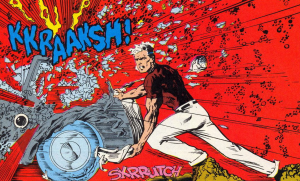Roy Thomas never met a Golden Age super-hero he didn’t like, a characteristic that certainly served the legendary writer-editor well over the decades.
His voluminous knowledge of comics’ original super-hero boom – and apparent awareness of copyright abandonment within the industry – led to Marvel’s surreptitious acquisition of the Ghost Rider, introduced elements of Bill Everett’s Amazing-Man to the origin of Iron Fist and provided Bronze Age fan-boys like myself endless hours of nostalgia-tinged fun via The Invaders, Liberty Legion and All-Star Squadron.
One of Thomas’ more memorable pastiches, Iron Munroe, emerged after DC Comics’ infamous Crisis On Infinite Earths reboot wiped out the publisher’s well-established parallel earths mythos and – in the process – demolished much of its Golden Age continuity.
DC’s new order left a “Super” sized hole in Thomas’ All-Star Squadron, necessitating a quick replacement for the Man Of Steel. Somewhere within his voluminous memory, Thomas recalled an extremely obscure character called “Iron Munro,” a space-opera hero reportedly based on John W. Campbell’s ’30s sci-fi character Aarn Munro.
Thomas mixed and matched the Munro moniker with Philip Wylie’s Gladiator and voila …
I’ve always been intrigued by the “real” Iron Munro, but never had the pleasure of reading any of the character’s stories until the advent of the Internet and what I’d like to call of Golden Age of Public Domain Comics sites.
I finally stumbled upon the character in the back pages of Shadow Comics #7 (Street & Smith, November 1940) and was pleased to discover his adventures were every bit as awesome as hoped.
(Satanic aliens! Jules Verne-styled spaceships!! Global destruction!!!)
The real discovery, however, is the identity of the story’s author: Theodore Sturgeon, one of the greatest science-fiction and horror writers of the 21st century. I’m not sure how the author himself would have graded Iron Munro under “Sturgeon’s Law,” but it’s always interesting to note how many pioneering science-fiction writers doubled as funny book scribes during the dawn of American comics.
The story is drawn by Jack Farr and is the apparently the final part of what modern readers would term a “multi-part arc.” Not to worry, though, Time Bulleteers. The Golden Age is the era of compressed comics, where all stories are summed up in one or two meaty captions!









